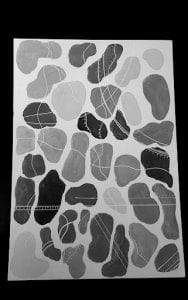In-Depth Blog Post #3
“Abstract art is not the creation of reality but the true vision of reality.” – Piet Mondrian

Progress:
Over the past two weeks, I have been focusing on colour theory and mixing colours. By only using the three primary colours and white and black you can create any colour. My mentor showed me this through two similar assignments. First, I was working on warm colours only which only involves using the base colours yellow, red, white, and black. I was told to create a small painting that acted as a colour palette and to add an extra element to it, I used a white posca pen and made markings over top of my shapes. (See below picture) I sent my mentor this photo after creating it and she told me to put a black and white filter over top. She explained later that this was to show the values (light and dark) of all the colours used in this painting. (See picture below) Something that has stuck with me is when she talked about how when abstract painting the values (light and dark) can be more important than the colours.


After completing my first painting and getting feedback from my mentor, it allowed me to take risks. In the first painting, you can see that I played it quite safe. I used all the same kind of rounded shapes, none of them touched, they are the same size and the lines of the posca pens are not as creatively chosen. In the second painting I made, I was instructed to create again a colour pallet concept. However, this time I used cool colours instead of using all the primary colours, black and white. I took risks this time and I believe I improved from my last painting. (See photo below) I created sharper lines, shapes that varied in size and shape, and creative posca pen markings.

After this assignment, I was told to work on my markings and try out different types to find my style and what I liked to create. To follow my theme of shapes, I decided to practice on a canvas with some painted shapes already as a background. (See photo below)

These next few weeks I will continue to work on different types of markings, and I will start to work with complementary colours.
Grounding the work:
1. What went particularly well during your mentoring sessions?
One part of the sessions with my mentor that went well are the conversations and comfortability we have talking with one another. Having my grandma as my mentor has given me a head start with the comfortability portion of In-depth. This has allowed me to ask more questions and take my learning more in the direction I want to go because of this comfortability. The conversations we have had stand out to me as well. My mentor doesn’t just talk the whole time we are meeting but allows me to ask questions and talk about what I want to learn. Her way of teaching is through showing me how to do something and why it works, then allowing me to ask clarifying questions, and ending off with me showing my learning through an assignment. I have found that this works quite well with how I learn.
2. What three strategies could improve the quality of your mentoring interactions?
- One way to improve mentoring interactions could be through having a list of tasks we want to cover each meeting. I find that in our meetings I learn a lot, but by planning beforehand what I want to learn I can prepare myself with what I need. Preparing could be buying material to make it easier or simply doing a quick google search to get an understanding beforehand. This can make my meetings more efficient and allow us to cover more ground in less time.
- Another strategy I can improve my mentor meetings is coming up with questions before the meetings. This can prevent random moments of silence and can help me understand concepts I am interested in and want to learn more about.
- I think that being more vocal in meetings is another way I can improve my mentor meetings. I find that in meetings I feel comfortable with my mentor, but they always end up doing most of the talking. This is great because there is lots of information to learn, but I think if I spoke up more and asked additional questions, I would get more out of our meetings.
3. What is the action plan for implementing each of the three strategies?
The best way to plan for what I want to accomplish is by talking it over with my mentor. Having a discussion before we start our meeting or over text will not take very long and it can keep us both prepared for upcoming meetings.
I find the best way for me to remind myself to do something is through notes I leave for myself. I have never been able to follow a planner, so by using various apps that show a list of tasks I need to accomplish on my phone, laptop or on a sticky note I can keep reminding myself. By using this method, I can write down different questions for my mentor before our next meeting. Preparing a few notes for myself before a meeting I think is a good way for me to allow me to speak up. 9/10 times I don’t speak up because I don’t know what to say and I don’t want to embarrass myself.
Thank you for reading my blog and I hope you continue to follow my journey!
Leave a Reply